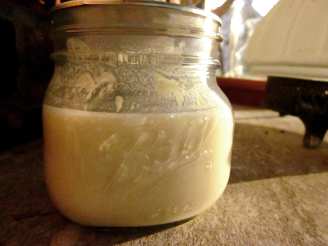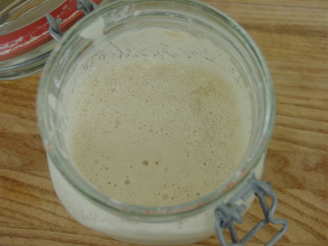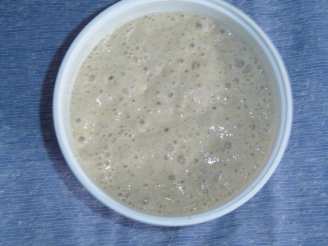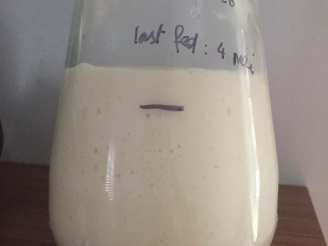Sourdough Starter

photo by Jonathan Melendez





- Ready In:
- 168hrs
- Ingredients:
- 5
- Yields:
-
1 starter
ingredients
-
Sourdough Starter
- 100 g whole wheat flour or 100 g whole grain rye flour
- 125 g water
-
Starter Feeding
- 50 g whole wheat flour or 50 g whole grain rye flour
- 50 g all-purpose flour
- 115 g water
directions
-
Day 1:
- You’ll need two large, wide-mouth Weck jars or Mason jars (1 quart size) for this process. First step is to weigh each jar (without the lid) and write that number on the bottom or somewhere else handy. This will be useful when we go to do the feedings each day.
- In the morning, combine 100 grams whole wheat flour or whole grain rye flour with 125 grams warm water (80°F) in one of the jars, and mix with a small rubber spatula until well combined. Cover (if using a Weck jar, do not use rubber gaskets or clips; if using a Mason jar, cover with a new lid, but do not tighten) and keep in a warm spot. I like to place mine in the oven, turned off, with the light turned on to create a slightly warm environment. Let the mixture rest for 24 hours.
-
Day 2:
- In the morning, place the second jar (empty) on the scale and tare to 0 grams. Add 75 grams of the starter mixture from the day before and discard the rest. Then add 50 grams whole wheat or rye flour, 50 grams all-purpose flour and 115 grams warm (80°F) water. Mix well with a small rubber spatula, cover and keep in the same warm spot for another 24 hours. Clean out the first jar and set aside for the next day.
-
Day 3:
- In the morning, place a new, clean jar on the scale and tare to 0. Add 75 grams of the starter from the day before and discard the rest. Then add 50 grams whole wheat or rye flour, 50 grams all-purpose flour and 115 grams warm (80°F) water. Mix well with a small rubber spatula, cover and keep in the same warm spot for another 24 hours. Clean out the other jar and set aside for the next day.
-
Day 4:
- At this point you might start to see some activity. Don’t be discouraged if you don’t. Be patient and continue on schedule as directed. This is the first day you’ll be doing two feedings—one in the morning and one in the evening (before bed).
- In the morning, place a clean jar on your scale and tare to 0. Add 75 grams of the starter from the day before and discard the rest. Then add 50 grams whole wheat or rye flour, 50 grams all-purpose flour and 115 grams warm (80°F) water. Mix well with a small rubber spatula, cover and let rest for 12 hours.
- After 12 hours (before bed), you can proceed with the second feeding of the day. At this point you can begin using only one jar. Discard all but 75 grams of starter. (This is where the jar weight you wrote down comes in handy. You’ll do the math, 75 grams + jar weight = target weight). Then add 50 grams whole wheat or rye flour, 50 grams all-purpose flour and 115 grams warm (80°F) water. Mix well with a small rubber spatula, cover and let rest overnight.
-
Day 5 and 6:
- In the morning, discard all but 75 grams of starter. Then add 50 grams whole wheat or rye flour, 50 grams all-purpose flour and 115 grams warm (80°F) water. Mix well with a small rubber spatula, cover and let rest for 12 hours. Before bed, repeat with the same measurements and let rest overnight.
-
Day 7 and onward:
- On the morning of the 7th day, discard all but 50 grams of starter. Then add 50 grams whole wheat or rye flour, 50 grams all-purpose flour and 100 grams warm (80°F) water. Mix well with a small rubber spatula, cover and let rest for 12 hours. In the evening, repeat the same process as the morning with the same measurements.
- At this point, your starter should be rising and falling each day predictably. If you’re at day 7 and you aren’t seeing constant activity, continue feeding until you see the rising and falling each day. Progress may vary depending on the temperature of your kitchen and water. At this point, you can start using your discard or your starter. Continue to feed it every day, twice a day, as long as you’re planning to make bread. You can also place your starter in the fridge and feed it once a week, if you don’t plan on making bread as often.
-
Equipment to make things easy for yourself:
- Two wide-mouth Weck jars or Mason jars (1-quart size) with lids.
- Small rubber spatula.
- Digital scale.
- Instant read thermometer.
Reviews
Have any thoughts about this recipe?
Share it with the community!
RECIPE SUBMITTED BY
Jonathan Melendez
North Hollywood, California
Jonathan Melendez is a passionate author, food photographer, cook, baker, and recipe developer whose blog, The Candid Appetite, has appeared prominently on such sites as, BonAppetite, People, Cosmopolitan, The Kitchn, Today, The Cooking Channel, Food52 and Joy the Baker. He has created and photographed recipes for Idaho Potato Commission, Wisconsin Milk Marketing Board, American Butter Institute and Jones Dairy Farm, to name a few. He lives in Los Angeles, CA.








